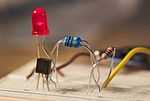Direct current/Field-effect transistor
< Direct current| Direct current |
|---|
 |
| General electronics |
|
|
|
Field-effect transistor The field-effect transistor (FET), sometimes called a unipolar transistor, uses either electrons (N-channel FET) or holes (P-channel FET) for conduction. The four terminals of the FET are named source, gate, drain, and body (substrate). On most FETs the body is connected to the source inside the package and this will be assumed for the following description.
A voltage applied between the gate and source (body) controls the current flowing between the drain and source. As the gate/source voltage (Vgs) is increased the drain/source current (Ids) increases roughly parabolically (Ids ∝ Vgs 2). In FETs the drain/source current flows through a conducting channel near the gate. This channel connects the drain region to the source region. The channel conductivity is varied by the electric field generated by the voltage applied between the gate/source terminals. In this way the current flowing between the drain and source is controlled.
FETs are divided into two families: junction FET (JFET) and insulated gate FET (IGFET). The IGFET is more commonly known as metal–oxide–semiconductor FET (MOSFET), from their original construction as a layer of metal (the gate), a layer of oxide (the insulation), and a layer of semiconductor. Unlike IGFETs, the JFET gate forms a PN diode with the channel which lies between the source and drain. Functionally, this makes the N-channel JFET the solid state equivalent of the vacuum tube triode which, similarly, forms a diode between its grid and cathode. Also, both devices operate in the depletion mode, they both have a high input impedance, and they both conduct current under the control of an input voltage.
Metal–semiconductor FETs (MESFETs) are JFETs in which the reverse biased PN junction is replaced by a metal–semiconductor Schottky-junction. These, and the HEMTs (high electron mobility transistors, or HFETs), in which a two-dimensional electron gas with very high carrier mobility is used for charge transport, are especially suitable for use at very high frequencies (microwave frequencies; several GHz).
Unlike bipolar transistors, FETs do not inherently amplify a photocurrent. Nevertheless, there are ways to use them, especially JFETs, as light-sensitive devices, by exploiting the photocurrents in channel–gate or channel–body junctions.
FETs are further divided into depletion-mode and enhancement-mode types, depending on whether the channel is turned on or off with zero gate-to-source voltage. For enhancement mode, the channel is off at zero bias, and a gate potential can "enhance" the conduction. For depletion mode, the channel is on at zero bias, and a gate potential (of the opposite polarity) can "deplete" the channel, reducing conduction. For either mode, a more positive gate voltage corresponds to a higher current for N-channel devices and a lower current for P-channel devices. Nearly all JFETs are depletion-mode as the diode junctions would forward bias and conduct if they were enhancement mode devices; most IGFETs are enhancement-mode types.
| | Search for Direct current/Field-effect transistor on Wikipedia. |